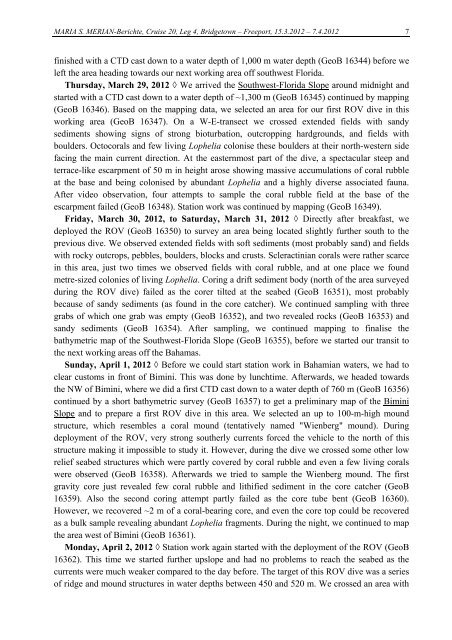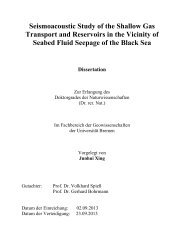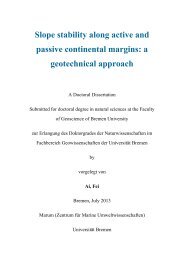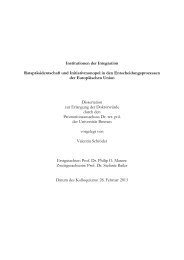aus dem MARUM und dem Fachbereich Geowissenschaften der ...
aus dem MARUM und dem Fachbereich Geowissenschaften der ...
aus dem MARUM und dem Fachbereich Geowissenschaften der ...
Create successful ePaper yourself
Turn your PDF publications into a flip-book with our unique Google optimized e-Paper software.
MARIA S. MERIAN-Berichte, Cruise 20, Leg 4, Bridgetown – Freeport, 15.3.2012 – 7.4.2012 7<br />
finished with a CTD cast down to a water depth of 1,000 m water depth (GeoB 16344) before we<br />
left the area heading towards our next working area off southwest Florida.<br />
Thursday, March 29, 2012 ◊ We arrived the Southwest-Florida Slope aro<strong>und</strong> midnight and<br />
started with a CTD cast down to a water depth of ~1,300 m (GeoB 16345) continued by mapping<br />
(GeoB 16346). Based on the mapping data, we selected an area for our first ROV dive in this<br />
working area (GeoB 16347). On a W-E-transect we crossed extended fields with sandy<br />
sediments showing signs of strong bioturbation, outcropping hardgro<strong>und</strong>s, and fields with<br />
boul<strong>der</strong>s. Octocorals and few living Lophelia colonise these boul<strong>der</strong>s at their north-western side<br />
facing the main current direction. At the easternmost part of the dive, a spectacular steep and<br />
terrace-like escarpment of 50 m in height arose showing massive accumulations of coral rubble<br />
at the base and being colonised by ab<strong>und</strong>ant Lophelia and a highly diverse associated fauna.<br />
After video observation, four attempts to sample the coral rubble field at the base of the<br />
escarpment failed (GeoB 16348). Station work was continued by mapping (GeoB 16349).<br />
Friday, March 30, 2012, to Saturday, March 31, 2012 ◊ Directly after breakfast, we<br />
deployed the ROV (GeoB 16350) to survey an area being located slightly further south to the<br />
previous dive. We observed extended fields with soft sediments (most probably sand) and fields<br />
with rocky outcrops, pebbles, boul<strong>der</strong>s, blocks and crusts. Scleractinian corals were rather scarce<br />
in this area, just two times we observed fields with coral rubble, and at one place we fo<strong>und</strong><br />
metre-sized colonies of living Lophelia. Coring a drift sediment body (north of the area surveyed<br />
during the ROV dive) failed as the corer tilted at the seabed (GeoB 16351), most probably<br />
bec<strong>aus</strong>e of sandy sediments (as fo<strong>und</strong> in the core catcher). We continued sampling with three<br />
grabs of which one grab was empty (GeoB 16352), and two revealed rocks (GeoB 16353) and<br />
sandy sediments (GeoB 16354). After sampling, we continued mapping to finalise the<br />
bathymetric map of the Southwest-Florida Slope (GeoB 16355), before we started our transit to<br />
the next working areas off the Bahamas.<br />
S<strong>und</strong>ay, April 1, 2012 ◊ Before we could start station work in Bahamian waters, we had to<br />
clear customs in front of Bimini. This was done by lunchtime. Afterwards, we headed towards<br />
the NW of Bimini, where we did a first CTD cast down to a water depth of 760 m (GeoB 16356)<br />
continued by a short bathymetric survey (GeoB 16357) to get a preliminary map of the Bimini<br />
Slope and to prepare a first ROV dive in this area. We selected an up to 100-m-high mo<strong>und</strong><br />
structure, which resembles a coral mo<strong>und</strong> (tentatively named "Wienberg" mo<strong>und</strong>). During<br />
deployment of the ROV, very strong southerly currents forced the vehicle to the north of this<br />
structure making it impossible to study it. However, during the dive we crossed some other low<br />
relief seabed structures which were partly covered by coral rubble and even a few living corals<br />
were observed (GeoB 16358). Afterwards we tried to sample the Wienberg mo<strong>und</strong>. The first<br />
gravity core just revealed few coral rubble and lithified sediment in the core catcher (GeoB<br />
16359). Also the second coring attempt partly failed as the core tube bent (GeoB 16360).<br />
However, we recovered ~2 m of a coral-bearing core, and even the core top could be recovered<br />
as a bulk sample revealing ab<strong>und</strong>ant Lophelia fragments. During the night, we continued to map<br />
the area west of Bimini (GeoB 16361).<br />
Monday, April 2, 2012 ◊ Station work again started with the deployment of the ROV (GeoB<br />
16362). This time we started further upslope and had no problems to reach the seabed as the<br />
currents were much weaker compared to the day before. The target of this ROV dive was a series<br />
of ridge and mo<strong>und</strong> structures in water depths between 450 and 520 m. We crossed an area with

















